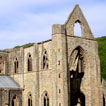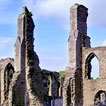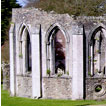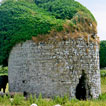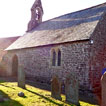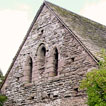Building for the Monastic Life
The first Norman lord of Abergavenny, Hamelin de Ballon, granted land by 1100 to the abbey of St Vincent at Le Mans in France for them to construct monastery in Abergavenny. It was the first Norman monastery to appear in South Wales, and the pattern of its foundation was to be followed by other: the grant of lands by an incoming lord in the first half of the 12th century to a monastic house of his choice in England or France. This house would then establish a presence on site by sending out a party of monks to establish a monastic cell, which would still remained dependent on its mother house. Other monks might then follow and enlarge this community into a self-governing conventual monastery, as happened at Abergavenny, Chepstow, Ewenny, Goldcliff and Monmouth. All these monasteries belonged to the Benedictine order.
By the second half of the 12th century, the newly formed Cistercian order proved much more attractive to the founders of monasteries. This movement was an attempt to return monasticism to its original values, with an emphasis on the monks living in isolated areas where they would not be distracted by worldly affairs and would support themselves by their own work. Extensive medieval remains are still visible of the Cistercian monasteries at Neath, Margam and Tintern, but others at Llantarnam and Grace Dieu (Monmouthshire) have completely disappeared. Almost completely gone are the remains of the friaries, founded in Cardiff in the 13th century for the Dominican and Austin Friars, and in Newport for the Austin friars in 1377. Unlike monasteries, friar preached and worked among ordinary people, like the Augustinian canons at Llanthony priory.
At the heart of any monastery was the church, with the cloister built along one side, usually the south. Administration and living accommodation was arranged around the cloister; an infirmary for sick monks usually stood behind where it was less busy. All these buildings formed the inner precinct, which could only be entered through a gatehouse. Beyond was the large outer precinct, which contained all the service buildings needed by a self-sufficient medieval community, including storage for agricultural produce. Entry to this precinct from the outside world was through the outer gatehouse.
Cistercian monasteries contained parallel communities of choir monks and lay brothers who slept and ate separately, but worshipped together in the church. Whilst life of the choir monks was to become based around what we normally visualise as happening in a monastery – a round of church services, private prayer and study – the life of the lay brothers was always focussed on manual labour, particularly agriculture. In order to farm their lands more effectively, Cistercian houses established networks of monastic granges with all the necessary agricultural buildings such as barns and dovecotes, where the lay brothers could live on site. They can be considered as the ´model farms´ of their day. Granges also had their own small chapels.
